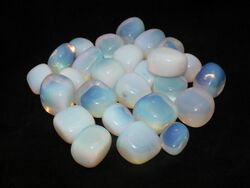Chemistry:Opalite

Opalite is a trade name for synthetic opalescent glass and various opal and moonstone simulants. Other names for this glass product include argenon, sea opal, opal moonstone, and other similar names.[1][2] It is also used to promote impure varieties of variously colored common opal.[1]
Natural opalite (as opposed to the man-made opalite) shares the same basic chemical properties as opal. It is made of tiny spheres of silicon dioxide, which stack onto each other in a pyramid grid shape. This grid is what allows the cat's-eye effect to be displayed when the stone is cut into a high-domed cabochon. Natural opalite is referred to as "common opal" to prevent confusing it with glass opalite.
When opalite glass is placed against a dark background, it appears to have a blue color. When placed against a light background, it is milky white with an orange or pink glow. Since it is glass, it may sometimes contain air bubbles, an after-effect of the forming process.[citation needed]
Usages
Opalite is mainly used as a decorative stone and is usually sold either tumble polished or carved into decorative objects. Some sellers will sell opalite as opal or moonstone.[citation needed]
References
- ↑ 1.0 1.1 Opalite, MinDat.org, http://www.mindat.org/show.php?id=5984
- ↑ Eckert, Allan W. (1997). The World of Opals. New York: John Wiley and Sons. pp. 107–08. ISBN 978-0-471-13397-1.
 |

